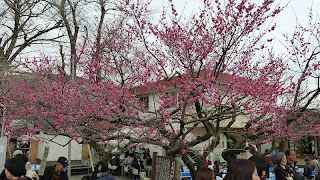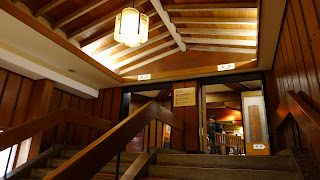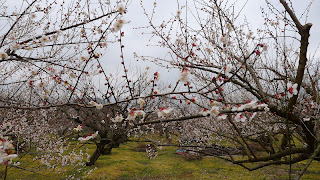Odawara is a cultural and historical town, and also one of the considerably famous tourist spots of Kanagawa prefecture. Last week, I was lucky to have enough free time (amidst my insanely busy study schedule) to visit this place. And now, the time has come for me to take you all on a tour. Please note, however, that this blog entry may be shorter compared to my previous ones, mainly due to the fact that the final exam is coming and I do have 50 Kanji characters to memorize each week.
I began my trip by boarding a direct train (Tokaido Line) from Kawasaki (where I live) to Odawara station. As a place with direct connection to Hakone, it's not surprising to see how large and busy Odawara station is.
The first spot on our trip is Odawara Castle. I shall not elaborate on how to get there since you can see the roof of the castle right after you leave the station's east exit. So my advice is to keep walking in that direction until you reach it eventually.
 |
| The castle is a perfect place for taking creative photography i.e. adding filters for antique effect. |
Odawara Castle was built by the Omori family in the mid-15 century. The inside of the building has been renovated into a museum displaying historical artifacts. (400-yen entrance fee required)
Once you reach the topmost floor of this castle, you can also enjoy a view of the entire Odawara city and Sagami Bay.
The trip from the station to the castle and back to the station again should not take too long (2 hours at most, unless you enjoy taking photos of the castle from every possible angle). After the coming back from the castle, I enjoyed(?) this average Japanese food set at a local restaurant near the station.
In the afternoon, I took a train from Odawara to Shimo-Soga station in order to view ume matsuri (or Japanese Plum Festival), the event where people enjoy the sight of blooming plum trees while doing picnic and watching various Japanese traditional events.
The Shimo-Soga station is the closest station to Soga Bairin (Plum Orchard), one of the most famous Japanese plum producing areas, where the beautiful white and ret blossoms of Japanese plum trees can be enjoyed with a view of Mt.Fuji as their background.
You can really experience a real countryside atmosphere by visiting this station, even the ticket machine is a vintage one.
Unfortunately however, when I got there most of the flowers have not blossomed yet. There were only about 10-20% of the plum trees that were blooming.
In dire situations like this, the best solution is to take photos of the flowers at extremely close distance so you can get photos that look as if the entire orchard is really blooming to show your friends later. ;)
Despite the plum's current state, the Ume Matsuri (Plum Festival) is still being held in the orchard. There are stage performances for visitors to enjoy here.
 |
| This one is the most impressive tree in the area. I think I've taken photos of it from all humanly possible angles already. |
Overall, I can't say that I picked the right time to visit the place. However, judging from the number of plum trees in the area, I can guarantee that it will look absolutely breathtakingly beautiful within the next few weeks. And if the weather is clear enough, you may even get a glimpse of Mt.Fuji from here as well. So I can conclude that this place is definitely worth a visit (at the right time, that is).
- Odawara castle can be accessed by taking a Tokaido Line train to JR Odawara station (the castle is 10-minute walk from the station. It is opened from 9:00-17:00
- Soga Bairin can be accessed by taking a train from Odawara station to Shimo-soga station (via JR Gotemba Line). The trip takes 18 minutes and 190 yen.
- Plum Festival is usually held from the beginning of February to the beginning of March









































No comments:
Post a Comment